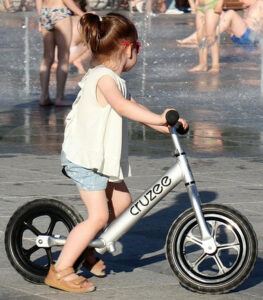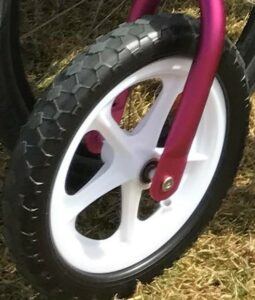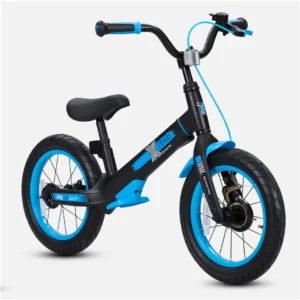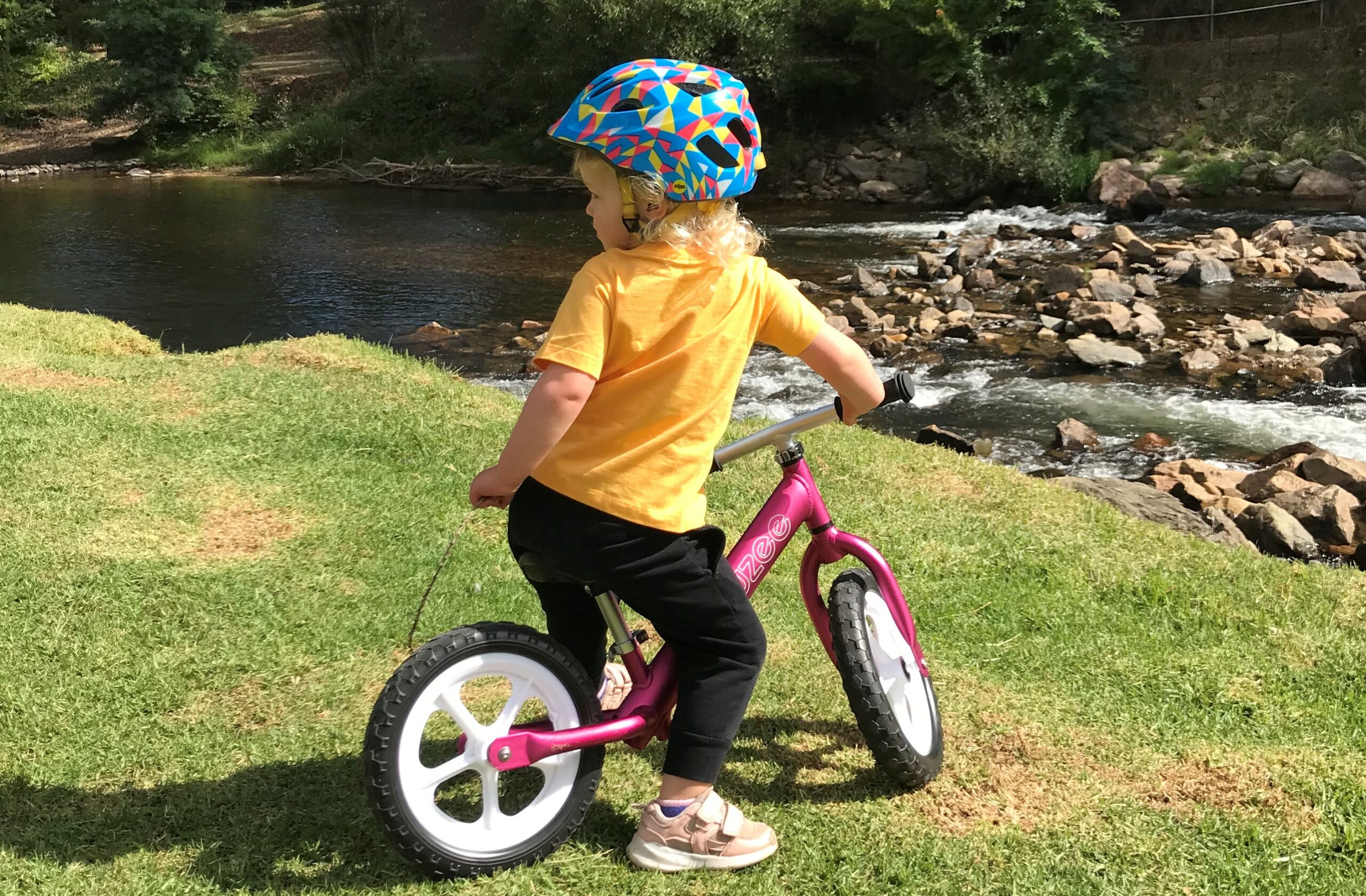
Is your child starting to explore new forms of transportation that will get them moving faster, further and burn off some much-needed energy?
Or maybe they have already shown an interest in getting a bike but you’re unsure as to which type of bike to purchase.
Well, you have come to right place, as we introduce you to the developmental powerhouse that is aka a kid’s balance bike.
Balance bikes for kid’s have been around since 1997, when German designer Rolf Mertens developed the first commercially produced running bike called LIKEaBIKE for children.
You can learn more about the history of the modern kid’s balance bike in our post The Evolution of the Balance Bike.
Basically, a kid’s balance bike is designed to allow your child to learn balance.
In addition, while learning to balance your child will be developing essential motor patterns such as steering, control of speed, riding awareness and hopefully gain a bucket-full of confidence before attempting to ride a bike with pedals.
These tiny balance bikes are lightweight, pedal, chain and drive train free and are captivating young riders everywhere while providing a super fun, safe and most importantly, correct method of teaching kids the fundamentals of cycling.
In our post, What Is a Kid’s Balance Bike? we will provide you with a brief overview of the good stuff. That parent-essential information that helps to not only answer our title question but provide you with a handy little balance bike 101 education package that will leave you feeling knowledgeable and empowered as you consider making a suitable choice of balance bike for your child.
Essentially, we are going to cover the following concepts;
- Balance bike description
- Balance bike benefits
- Balance bike size
- Balance bike age ranges, and
- Safety, materials and design features
- Overall ilovetoridemybike.com conclusion
So then, what exactly is a kid’s balance bike? Let’s find out!
Affiliate disclosure time: Some of the links on this page are affiliate links. If you click on those links and make a purchase within a time frame, we earn a small commission. Rest assured, the commission is paid by the retailers, not by you.
This commission helps keep ilovetoridemybike.com riding and writing. We thank you for your generous support. You are helping us continue doing what we love and that’s providing our customers with all the information they need to know about kids balance bikes.
Balance Bike Description
 To keep this nice and simple, technically we can say that a balance bike is a two-wheeled bike with no pedals, no chain, no drive train or gears. The balance bike is effectively propelled along by the rider using their feet on the ground to produce forward momentum.
To keep this nice and simple, technically we can say that a balance bike is a two-wheeled bike with no pedals, no chain, no drive train or gears. The balance bike is effectively propelled along by the rider using their feet on the ground to produce forward momentum.
The idea is simple. That is, for the rider to develop and learn balance!
That’s the key concept and skill that a balance bike somewhat majestically teachers its little rider’s as they begin their bike riding journey on a kid’s balance bike.
There are of course, additional benefits for your child that are quite amazing in their developmental qualities. Let’s take a look at these now.
Balance Bike Benefits
When we begin to discuss the benefits for kids riding a balance bike, the topic in itself is huge!
Simply put, the benefits are innumerable and amazing. So much so that we often refer to a balance bike in our posts as a developmental powerhouse dressed up as a toy!
We won’t dive deep into these benefits here, as this is not the focus of our article, but rather provide you with a brief list of the fundamental benefits that are important for you to understand and essentially complement our response to our title question, what is a kid’s balance bike?
Balance
First up, the number one benefit of learning to ride a balance bike, as already mentioned, is for kids to develop the essential motor patterns necessary for balance and steering.
Traditionally, if kids were learning on training wheels, they would develop incorrect motor patterns that we describe as the training wheel effect.
Essentially, young riders were learning to lean and steer the wrong way or to use a more technical term, counter intuitive to the correct motor patterns required when riding a pedal bike.
Luckily, a better option has been developed and is readily available.
Balance bikes allow children to walk, run and finally glide along as they intuitively develop the correct kinesthetic motor skills and coordination required to ride a bike.
Beautiful!
Physical benefits
Every time your little rider pops on a helmet and hops on their balance bike their muscles are getting a generous workout, working hard to complement one another, fine-tuning balance and movement (aka motor control) to produce that beautifully controlled polished result. A long glide!
The physical result, greater motor control and strength.
Almost subconsciously, they’re also improving their coordination and cardiovascular fitness, that is, their ability to do complete an activity for longer with increased control, endurance and strength.

Psychological benefits
As kids learn to ride, they are developing several psychological skills that are crucial to their overall development.
By simply riding a balance bike, kids are learning greater independence and autonomy, social and emotional benefits, including emotional self-regulation and a biggy, developing self-confidence.
When kids are provided with new and exciting challenges, particularly physical, these allow opportunity for deeper understanding of their own limitations, and how to behave when testing these boundaries in positive and socially acceptable ways.
Learning to ride a balance bike yields greater opportunity to grow not only physically, but socially and emotionally.
And we love it!
Next up, let’s take a quick look at balance bike size and material options.
Balance Bike Size
When talking balance bike size, there are two key pieces of information for parents to learn about. These are wheel size and seat height range.
Wheel Size
Balance bikes generally begin in the most widely available size option, this is referred to as a 12″ balance bike.
 A 12″ balance bike has 12″ diameter wheels (the rim diameter), a 10″ balance bike has 10″ diameter wheels, a 14″ balance bike has 14″ diameter wheels and so on.
A 12″ balance bike has 12″ diameter wheels (the rim diameter), a 10″ balance bike has 10″ diameter wheels, a 14″ balance bike has 14″ diameter wheels and so on.
There are some smaller options available with 10″ or 11″ wheels, such as the Norco Runner 10″, Kinderfeets Tiny Tot Plus, and the Baby Joy 11″ balance bike to name a few, but the most popular starting point for a kids balance bike begins at the 12″-wheel size.
Kids may very well ride a 12″ balance bike from around 18 months to 4 years, depending on the child’s size. Then, there are 14″ and 16″ balance bikes on the market that are more suited to kids aged 4 to 5+ years. For example, the Strider 14x has 14″ wheels and the Bixe 16 has 16″ wheels.
Strider 14x
Bixe 16
These larger balance bikes are great for kids not fully confident nor ready to give a pedal bike a go.
While wheel size is important, the number one piece of information to determine if a bike will fit your child is the seat height range.
Seat Height Range
If balance bike wheel size is queen, seat height range is king!
Readers, we want your full attention here 🙂
The seat height range is the seat height adjustability available for the balance bike.
For example, a seat may have a minimum height of 11″ and a maximum height of 16″, therefore the seat height range is 11″ to 16″ (5″ total).
Every balance bike will include an adjustable seat height to some degree. This may be just a few inches, or several. Here are a few examples.
- Woom 1 has 12″ wheels and seat height range 10″ to 14″ (4″ total)
- Strider 12 Sport has 12″ wheels and seat height range 11″ to 19″ (8″ total)
- Strider 14x has 14″ wheels and seat height range 15″ to 22″ (7″ total), and
- Bixe 16 has 16″ wheels and seat height range 18″ to 22″ (4″ total)
You can see from the above examples, that balance bikes do not have a consistent seat height range for a particular wheel size. These vary quite a bit. The key then, is to ensure your child’s inseam height fits within the balance bikes seat height range.
To find your child’s inseam height head on over to our post Balance bike set-up guide. In that post we explain how to find your little rider’s inseam, how to then find their optimal seat-height and, we give you some tips on how to make the suitable adjustments to your child’s bike.
Once measured, the child’s inseam allows you to know for certain if the bike will be suitable for your child, period.
Another post that you will find helpful is our Balance bike buyers guide which provides you not only with a re-cap on how to find your child’s inseam and optimal seat height, but then explains how to take this information and confidently go balance bike shopping.
Balance Bike Age Ranges
Balance bike manufacturers will give you a general guide for the age-range suited to their bike.
As alluded to above, this information, while helpful, doesn’t give you the key piece of information required so that you can be confident the bike will suit your child.
Remember, that key piece of information is your child’s inseam height, combined with the seat height range of the bike.
Age range information will typically be given in the product description. For example, Strider provides some great information on their website about size and fit that includes an age-range and the following;
- Ages: 18 months to 3 years
- Fits an inseam: 12″ to 17″ (11″ to 16″ seat height range), and
- Max. Rider weight: 27kgs
You can see that the age-range is more of a guide that the bike might fit your child, rather than a definitive confirmation.
We certainly recommend that you look at the age-range suggested, but most importantly be sure that your child’s inseam (and optimal seat height) fits well within the seat height range available.
Safety, Materials and Design Features
Balance bike designs are plentiful.
Some, however, are superior and provide some handy safety features for you to be aware of. The top features (other than seat height range and wheel size) we recommend looking for include the following.
Tires

You have two options here, air tires or foam.
Hands down, air tires are supremo as they provide greater traction and cushioning on all surfaces. These are heavier but do allow your little gem to more comfortably and therefore confidently handle any riding surface they can get their bikes onto.
Foam tires are maintenance free, as they are made of solid foam and therefore never go flat. These are also super light. They do a great job for smaller, less adventurous riders who stick to harder surface riding or grass terrain.
 Some balance bikes with air tires include the smarTrike Xtend (see image), Woom 1, Banana bike GT, Swagtron K3, Jeorge 12″ and the Vuly.
Some balance bikes with air tires include the smarTrike Xtend (see image), Woom 1, Banana bike GT, Swagtron K3, Jeorge 12″ and the Vuly.
Some balance bike options with EVA foam tires include the Strider 12 Sport, Kriddo, Cruzee Ultralight and the GOMO.
Materials
Balance bikes are most commonly made from either lightweight steel, aluminum, wood or bamboo.
Each material has its advantages and disadvantages. The most common materials are lightweight steel or aluminum, which are light, durable, recyclable and generally more practical in their design rideability.
Remember, balance bikes are unique, so too is your child. It really is a matter of looking at the available materials and deciding if this suits the unique needs of your budding rider.
So, be sure to explore the different options available while making sure the bike will suitably fit your child.
Remember, the key is inseam height and seat height range!
Weight
For parents wanting to ensure they have the right balance bike for their child, when it comes to weight there is a nice rule to follow.
Be sure the balance bike weighs no more than 25-30% of your child’s weight. That’s it!
The reasoning is also just as straight forward.
You child is tiny when first learning to ride a bike and all weight is relative. We want the bike to be as light as possible so that our little rider’s out there can learn to ride with ease, not having to wrestle a heavy bike that is difficult to maneuver.
The bike should allow the rider to effortlessly control the steering and speed while learning the fundamental skills of balance and those intuitive to cycling.
Let’s take a look at a quick example to help you understand how to use this rule when going balance bike shopping.
Example Rider
Rider weight: 15kgs
Balance bike weight: 3kgs (Strider 12 Sport)
Calculation: 30% of 15kgs = 0.3 multiplied by 15 = 4.5kgs (max. recommended balance bike weight)
You can see that the Strider 12 Sport weights less than 30% of our example rider’s weight and therefore taking weight into consideration only, would be a suitable option.
Brakes
Many balance bikes don’t include brakes and there is speculation in the balance bike world as to their necessity.
Our recommendation is simple. If this is within your budget, definitely purchase a balance bike with a handbrake.

But why?
When a child is learning how to ride a bike, controlling their speed is an essential skill that will help make the transition to a pedal bike smoother when the time comes.
If your future riding champion is learning how to use a handbrake on a balance bike, they will have greater control of their speed and therefore more confidently engage with new and exciting adventures.
The fine motor skills, coordination and skill required to ride using a hand brake will be fast tracked, allowing your child to be streets ahead in this component of cycling as they grow and mature on their bikes.
For some great examples of bikes with a hand brake check out the smarTrike Xtend, FirstBike Cross and the Woom 1.
Steering Limiter
Some balance bikes are designed with a steering limiter. This feature essentially limits the amount of steering available to the rider, so that they cannot over steer at any time. Again, there is some conjecture as to the necessity of this feature.
Yes, this does prevent over steering, which can at times lead to a fall, but it can also cause a safety hazard during a fall as the balance bike’s handlebars will be angling upwards and may cause an injury if a child falls onto these.
As mentioned, there are advocate’s and critics that will argue either way regarding their usefulness. In our opinion, we have seen both in action (bikes with or without steering limiters) and believe these are not necessary.
A child will learn and adapt quickly without a steering limiter attached to their bike.
For some examples of bikes with steering limiters see the Woom 1, GOMO and FirstBike Cross.
Footrests
Footrests are designed to provide a tiny, neat little platform for the rider to place their feet while gliding.
Most balance bikes have this feature and there are a variety of designs out there depending on the brand of bike.
The better footrests sit back almost in line with, or behind the seat position when viewed from the top of the bike looking down. These will be so discrete that you will virtually not even notice they are a part of the bike.
Some nice examples are found on the GOMO, Strider 12 Sport, smarTrike 3-in-1 Xtend, and Rolla balance bikes.
In a word, we like this feature, as we believe it provides a safe, and for us cyclists out there, aerodynamic platform that encourages a neat riding position when your child is gliding along.
That being said, these are not essential as kid’s intuitively learn to glide with their feet forward or backward as they glide. We encourage you to first and foremost ensure that the bike has the correct seat height range and wheel size suited for your child.
Conclusion
Thanks for reading our latest post that hoped to answer our title question for you, What is a kid’s balance bike?
Here’s a quick re-cap of what you have learnt.
- We have described exactly what a balance bike is
- We have provided you with some major benefits for riding a balance bike
- We looked at balance bike sizes
- We discussed age-ranges available, and
- We finished with a summary of safety, materials and design features
We hope that you enjoyed learning more about the world of balance bikes and that you found our post helpful.
If you have any questions or comments, please leave these below, we love to hear how your child’s riding is going and are here to help.
Happy riding!



Hey a great post you have here!
Wow I’m amazed at how many benefits come along with balance bikes. I knew there were a few physical benefits of riding a balance bike but never thought there were Psychological goodness too!
Wheel size actually make a difference, that’s interesting to see. Next time if we are considering purchasing bikes for the nursery children, these are some of the points to certainly look at.
Thank you and have a great day!
Hi, your most welcome!
Thanks for your comments and feedback. We are so happy that you found our article helpful.
Yes, the benefits are simply amazing mainly due to the period of life that balance bikes are introduced to a child, they are primed for development in all aspects.
If you are looking for balance bikes for nursery aged children (around 3-5 years old) then I definitely recommend 12″ wheels on their balance bikes.
Let us know if you have any questions, we are here to help! happy riding.
Hey Dale! I stumbled upon your article on kids’ balance bikes during a late-night Google rabbit hole, and I must say, it’s been an enlightening read! I never knew these little pedal-less wonders existed, but I’m now a balance bike evangelist – or at least, I will be when I get one for my niece’s upcoming birthday.
I’ve seen kiddos wobbling their way through the park on traditional training wheels, and I’ve always thought there must be a better way to teach them to ride. It seems balance bikes might just be the answer I’ve been looking for. Watching kids glide around effortlessly while developing essential biking skills has got to be the most wholesome thing I’ve seen in ages!
I do have a question, though – how does one choose the right size for a balance bike? I’d hate to buy one that’s too big or too small for my niece, and end up with a balance bike that gathers dust instead of conquering the playground.
Finally, do you have any tips or tricks for encouraging kids to transition from a balance bike to a proper bike? I’d love to know how to make the process as smooth and tear-free as possible.
Thanks a ton for this insightful article, Dale. You’ve changed the way I see kids’ biking, and my niece will undoubtedly benefit from it. Keep up the great work!
Hi Bob,
Firstly, thank you so much for your positive comments, we are so glad that our article has really helped and enlightened you to the better way to teach a child to ride a bike.
We are with you 100%, these are the best developmental tool a anyone can buy for a child wrapped up in a toy, and they are super fun too.
Regarding your questions, in our post we recommended two of our previous articles, both will help you to find the right size balance bike for your child and teach you how to measure the key information you need, your child’s inseam height (and what to do with this). These articles are called
Balance Bike Buyers Guide, and Balance Bike Set-up guide.
Balance Bike Buyers Guide – ilovetoridemybike
Balance Bike Set-Up Guide – ilovetoridemybike
And yes, we do have some tips and tricks, or better yet, a structured walk-through for you to teach your child how to ride a balance bike and then transition to a pedal bike you will find here at
How To Teach Your Child To Ride A Bike – Part 1 – ilovetoridemybike
and How to teach your child to ride a bike, Part II here;
How To Teach Your Child To Ride A Bike – Part 2 – ilovetoridemybike
Check these out on our website and let me know if you have any questions.
We are happy to help and even happier to hear that you have been enlightened to the wonderful world od kids balance bikes.
Happy riding!
I love your article Dale and especially the name of your site as it reminds me of the lyrics to the old Queen song from the 1970s or ’80s.
The balance bike is a tremendous tool for helping a kid learn their way around a bicycle without being overwhelmed by everything present on a fully functional bike before the young user actually needs those things.
It takes a good while for some newcomers to feel comfortable and the balance bike has nothing to rush them beyond their proficiency.
You talk about the options in kids sizes but I wonder do they manufacture balance bikes in adult sizes?
Hi Joseph, thanks for your comments and questions. We are glad you enjoyed our article.
Yes, so true. I hadn’t thought of the Queen song that you are talking about when creating our website, but maybe one day I might be able to team up with Queen’s song and create some fun advertising!
Regarding your question, are there any balance bikes for adults? Yes, there are a few available on the market.
The best idea I would recommend is for you to purchase a pedal bike that you like and remove the pedals and if you like, the cranks and drive train.
That way you can convert this back to a pedal bike if you would like to at some point.
These work just as well and this is a recommendation that we make for kids bikes too!
Thanks again for your comments and following us. Happy riding!